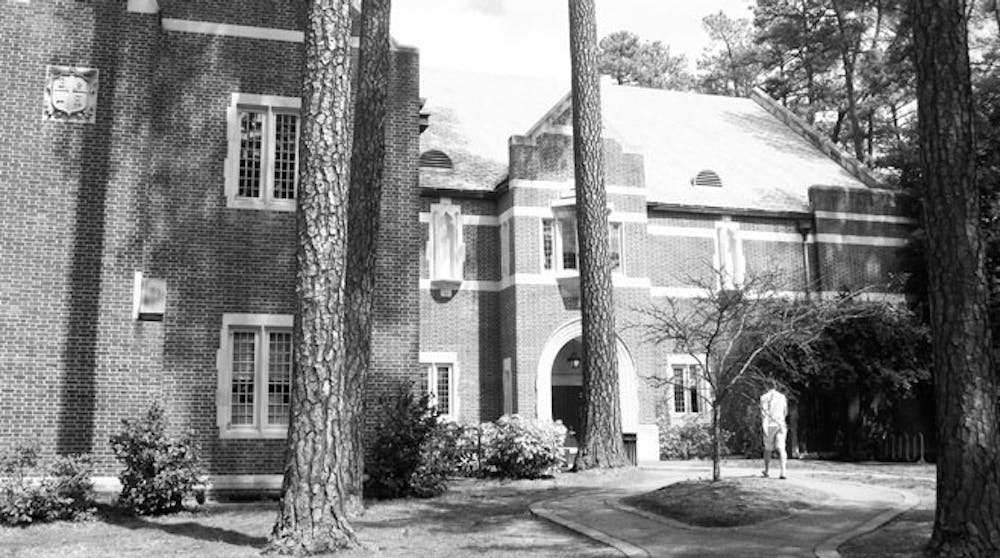"A sociological first expedition down the B-School Trail"
HYPOTHESIS: The B-School is actually a secret fraternity where members take pong lessons ... in suits.
LITERATURE REVIEW: An early lesson at Richmond: bypass the "major" question. Nine times out of 10 (especially for males) the answer was: business. And I'd have no reference for the species' daily reality as they disappeared down the isolated, one-destination path ... to the B-School.
For School of Arts and Sciences students, as abstract as the School of Leadership may seem, we at least frequent Jepson for classes, lectures and computers. But all students have core A&S requirements, there is nothing to lure those of us who cried our ways through Calc to the B-School.
"You have no reason to go inside if you're not a major or a confused freshman," fellow researcher Nelle Seymour said. "If you're not in the frat, you shouldn't be going in."
The withering economy yet leaping B-school rankings make the timing of our expedition ideal. The steam from the pot of curiosity has been rising for some time. And with last month's AIG bonus scandal and a New York Times article titled, "Is It Time To Retrain B-Schools?" its contents have reached their boiling point.
METHODOLOGY: The pine-tree-protected fortress looming on its own hill, apart from the lay student's academic quad, appeared too intimidating to penetrate alone. Such an expedition would need a crew.
My original plan of inserting golden tickets into candy bars at ETC was not received favorably by the IRB. According to the rejection notice, students actually getting their money's worth for their meal plans fell under the category of unspeakable offense.
Luckily, mine was not an isolated case.
Two juniors, Seymour and Curtis Perzinski, had also gone almost three years never having set foot in the B-School.
Trading Willy Wonka for Oregon Trail, we set off in our covered wagon on the weary journey west. Fording the lake, we lost two oxen and, later, Curtis to typhoid fever.
Seymour and I rested on the Westhampton shores to collect our strength and devise a strategy. We practiced reciting equations I'd pilfered from a friend's finance flash cards and phrases such as "The Dow topped 8,000 points yesterday," which might be traded like "Legends of the Hidden Temple" pendants if cornered by Temple Guards with briefcases.
Enjoy what you're reading?
Signup for our newsletter
As the path split after Puryear, the oxen pulled left on autopilot. But we coaxed them to stay the course, finally getting our chance to traverse the path on which we'd seen countless B-School students mysteriously emerge and vanish throughout the years.
Pausing at the curb like Charlie and Grandpa Joe peering through the Wonka Factory gates, we surveyed the multiple entrances until we had our first sighting: A B-school student disappeared into his natural habitat through door No. 2.
We hesitated at the door like freshmen approaching their first apartment party ("You go first. No, you.") Hearts pounding, we finally opened it and were met by a sterile smell but a refreshing temperature.
The Wall Street Journal with which we had armed ourselves before entering the student lounge did not fool the acute non-B-School radar. A specimen immediately called us out for trespassing. She exposed our lack of socialization to the norms of the B-School culture, meeting our timid greeting with, "Why are you whispering?"
RESULTS: The B-School is puzzlingly thin, its width rivaling the Commons hallway. At its heart is a student lounge under skylights and flags two floors overhead, flanked on either side by classrooms and offices.
Pong tables were not apparent (or are kept in secret wings. Judging from the exterior's size, the interior cannot be that narrow). Nevertheless, solo cups had been stashed -- the socializing more D-hall (study groups separated by sex) than apartment party.
The four entryway paintings seemed an interdisciplinary attempt, but their calculated, geometric lines betrayed their nature titles ("Radish," "Fern," "Peony" and "Evening"). Naked bulletin boards marking professors' offices also made clear: these folk were strictly business.
The Wall Street Journal racks and bathrooms arose every 5 feet. Strips of computers and phones did not even allow for sitting down.
Nevertheless, T-shirts, not suits, were the preferred dress. (But it's possible they just endorse casual Fridays.)
The water fountains were not segregated B-School and non-B-School. But students had clearly been more Calc BC/DE/FG wizards than wordsmiths in high school -- the abundance of plaques that marked "stairs" and "first floor," as if for a 5-year-old or ESL student learning English, struck researchers as unnecessary. As did classroom titles (e.g. "The Circuit City Classroom").
DISCUSSION: After timidly observing students and professors, we finally opened a dialogue, as a) without it, our observations would've remained regrettably shallow and b) it would prove to have been the missing link all along.
Students stressed they're in the B-School because it's what they're good at, not because they want to bathe in money.
"I have to be here," said one, explaining she can't write papers as A&S majors can.
But other stereotypes remained. Majors generally know who's in the club, and according to one female, "The guys are assholes."
But as everyone we met seemed rather friendly, our initial intimidation grew arbitrary. What did not was the difference in training styles between the schools.
"All the classrooms look really sterile ... not discussion-based," Seymour noted of the rows of two-person desks and tiered concentric arcs. The centering of the professors' lecterns, as opposed to their placement off to the side as in other buildings, favored the Socratic-method business lectures rather than discussion-driven A&S classes.
Students said this meant they had to be 100 percent prepared for every class, unable to hide behind vague opinions of questionably read readings as many A&S majors could.
Enjoying the privilege of attending our first business class with the apparently most terrifying, highest-paid-at-Richmond and best accounting professor in the country, Joe Hoyle, Seymour and I understood. Students didn't ask questions -- they were questioned.
We also saw how clueless we were, as all I could make of the categories written on the board ("Books 1 2 3 4 5 Never") was that they violated parallel construction.
CONCLUSIONS: Seniors especially, with only three weeks left, don't graduate with an inch of this campus untread. Besides the entertainment value, your perspective needs it (and tuition certainly pays for it).
Although B-school methods obviously get the job done, if economic scandals and crises have taught us anything, we should be breeding humans, not manufacturing machines.
Move some chairs around; let them ask questions.
Non-B-schoolchildren, we've enabled the problem by being too intimidated by business jargon to expose ourselves to things we should know (e.g. what a derivative is before the trading of them takes us all down).
Lucky for us, President Ayers is on it. Greater fluidity between the schools is part of the Strategic Plan, finance department chairman John Earl said, citing current hurdles of prerequisites and space-availability for even business majors.
And so was my daily horoscope: "You can't go through life surrounded by like-minded people, and that's a good thing."
Contact opinion editor Maura Bogue at maura.bogue@richmond.edu
Support independent student media
You can make a tax-deductible donation by clicking the button below, which takes you to our secure PayPal account. The page is set up to receive contributions in whatever amount you designate. We look forward to using the money we raise to further our mission of providing honest and accurate information to students, faculty, staff, alumni and others in the general public.
Donate Now

